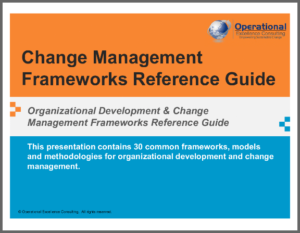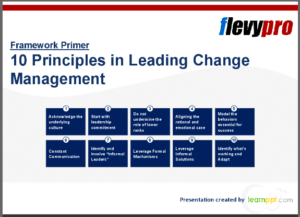The Satir Model for Change provides a very personalized approach to the stages that we as individuals, teams, and even organizations pass through during times of change. This post examines what the Satir Change Model is, how it is an important consideration for strategy, and how project managers can leverage it to provide leadership.
What Is the Satir Model for
Change?
 The Satir Change Model – also sometimes called the Satir Growth Model – was developed by Virginia Satir, a family therapist. The model is targeted to help people improve the way they cope with disruptive change. While it certainly applies to family therapy, it has come to be accepted also for people coping with organizational change.
The Satir Change Model – also sometimes called the Satir Growth Model – was developed by Virginia Satir, a family therapist. The model is targeted to help people improve the way they cope with disruptive change. While it certainly applies to family therapy, it has come to be accepted also for people coping with organizational change.
The power of the Satir Change Model is encapsulated in the following short quote from Virginia Satir:
“Life is not what it’s supposed to be. It’s what it is. The way you cope with it is what makes the difference.”
Virginia Satir
The core of the model is the curve, depicted above, showing the five stages of change:
- Late Status Quo – interrupted by a Foreign Element
- Resistance – non-acceptance of the need for the change
- Chaos – period of struggle eventually interrupted by a Transforming Idea
- Practice and Integration – assimilation of new routines and habits into the day-to-day
- New Status Quo – new stage of stability
One of the key challenges is predicting the effect of changes on performance. The curve in the diagram shows that the New Status Quo will be at a higher level of performance and productivity.
But the Satir Model focuses on tracking performance – which does not necessarily guarantee enhanced performance.
Let’s go deeper…
Phase 1 – Late Status Quo
 Whether it is an individual, or team or even company, there is a well-established way of working. The Status Quo involves doing things the way they have worked – probably for a long time.
Whether it is an individual, or team or even company, there is a well-established way of working. The Status Quo involves doing things the way they have worked – probably for a long time.
Individuals and teams generally feel comfortable with what they are doing and how they are doing it. They feel comfortable with each other. Expectations are clear, and experience, knowledge, and capability are well-aligned with current activities.
In some cases, even though a disruptor – known in the Satir Model as a ‘Foreign Element’ – has not appeared, there may be a lingering sense of change coming, or sometimes even a sense of ‘calm before the storm’.
In other cases, change may not be in the mind of anyone. There may be no sense of a need for a change. Often in this case, people do not have a sense of the big picture – for if they did, they would be clearer on risks, trends, and inevitabilities that could be at work and will eventually bring change.
The toughest, but most rewarding, thing is to recognize the possibility of change before anyone can feel it and before a ‘Foreign Element’ arrives.
Phase 2 – Resistance
 The Late Status Quo is over; it ended with the arrival of the Foreign Element, which disrupted the stability that existed.
The Late Status Quo is over; it ended with the arrival of the Foreign Element, which disrupted the stability that existed.
This Foreign Element can be experienced by everyone, or by select groups of individuals, such as C-suite executives, front-line employees, or sales people.
Since things were going so smoothly, and since everything was so well-aligned in the Late Status Quo stage, there is naturally a Resistance to the change. Often this Resistance is simply a denial that change is needed.
The period of stability may remain for a while…but soon enough, reality sets in – whether accepted or not – and performance declines.
Phase 3 – Chaos
 With the decline in performance, the stability that was enjoyed transforms into Chaos. While productivity has declined, a better description is that it is erratic.
With the decline in performance, the stability that was enjoyed transforms into Chaos. While productivity has declined, a better description is that it is erratic.
Emotions are high in the Chaos phase. It is difficult for anyone to see beyond it. However, the perspective of the Satir Change Model provides some hope that things will improve – that the team can find its way out of the abyss of the Chaos stage.
The oscillating performance during the chaos stage is caused by people grabbing onto bits of the past through resistance, seeing glimpses of hope for a different and better future, and cycling up and down emotionally.
The Chaos stage can be anticipated in any type of change. If the change is one being executed as part of a program, it stands a chance of being less painful if managed right. If it is a forced change based upon some condition changing disruptively, then the best antidote to the pain is the hope of seeing it through the process to the next step.
Ultimately, the appearance of a Transformative Idea is what begins to pull individuals and teams out of the depths of the Chaos stage.
Phase 4 – Practice and Integration
 With the Transformative Idea, the team is pulling out of Chaos, but the new and different future is still not secure. It is more of a ‘potential’ solution and takes Practice and Integration to realize increased performance and productivity.
With the Transformative Idea, the team is pulling out of Chaos, but the new and different future is still not secure. It is more of a ‘potential’ solution and takes Practice and Integration to realize increased performance and productivity.
Practice and Integration are necessary to actually put the knowledge, individual capability and systems in place to make the transformative part of the change occur.
Where the Foreign Element created a need for a change, and a Transformative Idea provided a vision for a changed and improved way, improved performance does not become real until solid execution happens in the Practice and Integration phase.
This is similar to the ‘Ability’ element of the ADKAR Model, where Knowledge is transformed into Ability, or competency, such as with knowing, practicing, then mastering a golf swing.
Phase 5 – New Status Quo
The New Status Quo marks the arrival of a fresh, new, and hopefully better Status Quo. If planning, vision, and the adoption of a truly good Transformative Idea was undertaken, then the New Status Quo should be better than the old. Productivity and Performance should be improved from the Late Status Quo.
It is critical to monitor and control especially during the early New Status Quo phase to ensure that people do not revert back to old familiar ways, or otherwise veer off course. This tendency is captured in the ADKAR Model’s Reinforcement phase, which acknowledges the need to reinforce the knowledge and ability that has been gained through the change.
Strategy and the Satir Model for Change
Strategy is all about seeing ahead – seeing the need to change, and devising the best approach forward.
The Satir Model provides a framework not only for implementing, but for seeing clearly the challenges and barriers ahead. Accepting and incorporating the realities of change into strategic plans only makes sense.
—————————————-
I recommend these strategy resources on FlevyPro (paid links):
| Change Management Frameworks Reference Guide 402-slide PowerPoint deck $179.00 |
Change Management Models 136-slide PowerPoint deck $59.00 |

|

|
| 10 Principles in Leading Change Management 17-slide PowerPoint deck $25.00 |
Lean Change Management 21-slide PowerPoint deck $25.00 |
 |
 |
—————————————-
Change management is by definition in the domain of implementation, so in that sense it is not strategic. However, thinking strategically and devising strategies cannot be done in a vacuum. Consideration of implementation challenges is a necessary and important consideration, and mastery of implementation concepts such as the Satir Model helps.
Project/Program/Portfolio Management and the Satir Model for Change
It’s one thing to know the various phases of change – in this case, as depicted by the Satir Model. But how do you actually cope with these phases, as a project manager – and lead your team through them?
- Late Status Quo – The problem in the Late Status Quo stage is that people not only don’t see change coming, but don’t see a need to change at all. Things are going well. As a project, program, or portfolio leader, you many not even see the change coming. To keep people from being too ingrained in their ways – a prelude of resistance – it can be helpful for all to work proactively to stimulate creativity, listen attentively, to look for things to learn, and to develop an outlook of resiliency and agility. Talking about how good things are – and how they might change – can stimulate that interaction.
- Resistance – The introduction of the Foreign Element will not be met with as much resistance if some action was taken in the Late Status Quo. In fact, the appearance of the Foreign Element at best would have been expected! The leadership focus now is on acceptance – rejection of denial. The focus needs to be on the potential ways to move ahead – and not on how to restore the old Status Quo.
- Chaos – Emotions peak in the Chaos phase. Not everyone on the team will be in the same place, but as team leaders we must work to bring everyone along, whatever the barriers. This is a time for mutual support across the team – nurturing the idea that the only way out is a new way, which we will find. The ultimate focus, while handling the emotions, is on potential Transformative Ideas that could lead the way out of the abyss. One risk in the Chaos stage is to jump on a sub optimal solution. Create an atmosphere of patience and facilitate careful thought and evaluation of potential solutions.
- Practice and Integration – In this stage it is time to set goals again. There are new things to schedule and monitor – measurable progress to be made. The idea is to implement, to crystallize new habits and ways of doing things across the team. Help people take ownership of the new way. Make sure people are doing what needs to be done to elevate performance, measure along the way, and make room for celebration of progress.
- New Status Quo – The new way of doing things must remain. Be cognizant of the tendency for some individuals to revert back to old and familiar ways; their still may be some laggards. Take some time with the team to review what you have been through together, talk about what has been learned through the process, and plant some seeds for the day when the New Status Quo eventually becomes the Late Status Quo.
The job of the project manager is to lead through change, while maintaining team effectiveness and performance all along the way.
—————————————-
I recommend these PM templates (paid link):

—————————————-
The Good and Bad About the Satir Model
While the Satir Model has merit, here is a realistic sketch of strengths and weaknesses.
Strengths – What’s good about the Satir Model?
- Provides a framework to anticipate change before it actually happens
- Introduces an important distinction between the Need to Change and the Change itself
- Provides justification for change projects
- Illuminates ways to create links to performance
- Points out the need for holistic and multifaceted performance metrics, such as Balanced Scorecards
Weaknesses – Where does the Saitr Model fall short?
- Only effective when supported by an actionable, measurable framework – like a project with relevant metrics
Conclusion and Further Resources
Gaining perspective from a framework like the Satir Change Model is a big help to leaders in rallying the team and addressing blockers at each phase.
Do you have a change leadership experience you can share?
I recommend the following “Satir Change Model” video – a bit agile centric – by Chris Sims of AgileLearningLabs:
A much more ‘personal’ approach is given in the following video, but it still ties to the same Satir Change Model process in a very natural way:
“Satir Model, the Process of Transformational Change”, by Anne Lindyberg – bridges over into ‘the process of transformational change’
